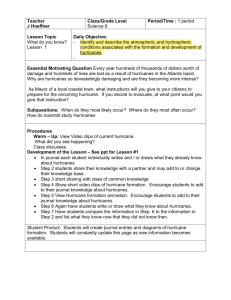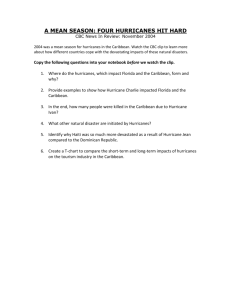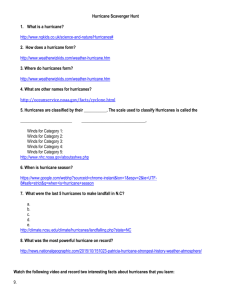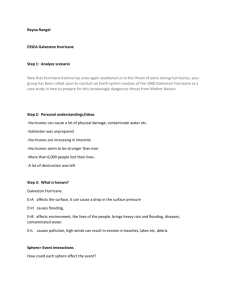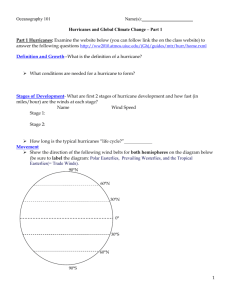Are Hurricanes Uninsurable
advertisement
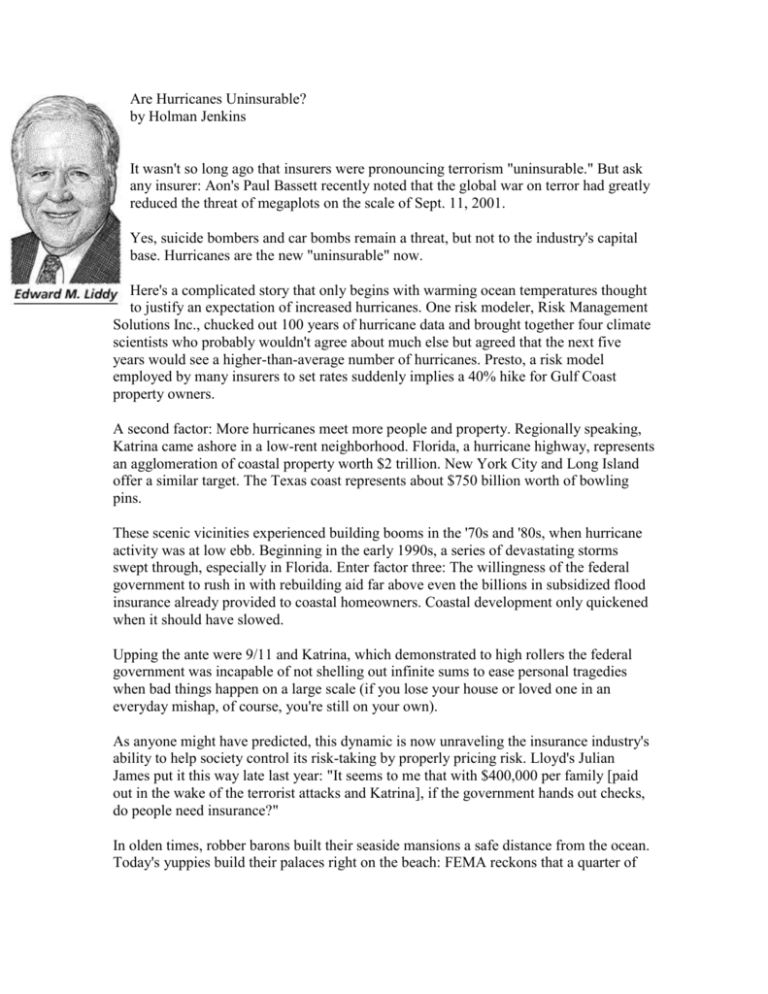
Are Hurricanes Uninsurable? by Holman Jenkins It wasn't so long ago that insurers were pronouncing terrorism "uninsurable." But ask any insurer: Aon's Paul Bassett recently noted that the global war on terror had greatly reduced the threat of megaplots on the scale of Sept. 11, 2001. Yes, suicide bombers and car bombs remain a threat, but not to the industry's capital base. Hurricanes are the new "uninsurable" now. Here's a complicated story that only begins with warming ocean temperatures thought to justify an expectation of increased hurricanes. One risk modeler, Risk Management Solutions Inc., chucked out 100 years of hurricane data and brought together four climate scientists who probably wouldn't agree about much else but agreed that the next five years would see a higher-than-average number of hurricanes. Presto, a risk model employed by many insurers to set rates suddenly implies a 40% hike for Gulf Coast property owners. A second factor: More hurricanes meet more people and property. Regionally speaking, Katrina came ashore in a low-rent neighborhood. Florida, a hurricane highway, represents an agglomeration of coastal property worth $2 trillion. New York City and Long Island offer a similar target. The Texas coast represents about $750 billion worth of bowling pins. These scenic vicinities experienced building booms in the '70s and '80s, when hurricane activity was at low ebb. Beginning in the early 1990s, a series of devastating storms swept through, especially in Florida. Enter factor three: The willingness of the federal government to rush in with rebuilding aid far above even the billions in subsidized flood insurance already provided to coastal homeowners. Coastal development only quickened when it should have slowed. Upping the ante were 9/11 and Katrina, which demonstrated to high rollers the federal government was incapable of not shelling out infinite sums to ease personal tragedies when bad things happen on a large scale (if you lose your house or loved one in an everyday mishap, of course, you're still on your own). As anyone might have predicted, this dynamic is now unraveling the insurance industry's ability to help society control its risk-taking by properly pricing risk. Lloyd's Julian James put it this way late last year: "It seems to me that with $400,000 per family [paid out in the wake of the terrorist attacks and Katrina], if the government hands out checks, do people need insurance?" In olden times, robber barons built their seaside mansions a safe distance from the ocean. Today's yuppies build their palaces right on the beach: FEMA reckons that a quarter of coastal dwellings will be destroyed in the next half century. The solution seems obvious: Restore the incentive for yuppies to behave responsibly like the robber barons. This assumes two things: Insurers would have to be free to charge realistic rates, which is problematic given that rates in most states are approved by elected or appointed insurance commissioners, most of whom have their eyes on higher office. It also assumes state courts will uphold insurance contracts -- a principle being tested in Mississippi, where Attorney General Jim Hood likens insurers to "Nazis in lockstep" and is pursuing civil and criminal complaints against them for refusing to pay for flood damage explicitly not covered in the policies they sold to homeowners. The riskiest assumption of all is that property owners would be willing to pay "actuarially sound" rates rather than just skipping insurance and relying on a federal bailout in the wake of a big storm. Here's the real crux of the claim by some industry watchers that hurricanes have become effectively uninsurable. In this camp is Robert Litan, a Brookings Institution economist who says bailouts have become politically mandatory and property owners expect them. So the only rational course now is to fund them in advance, with taxes borne mainly by those who benefit. Coming to a similar conclusion is Allstate CEO Ed Liddy, a one-man band who's been trying to drum up enthusiasm for a federal disaster insurance program. He was a voice alone but lately has acquired allies in the form of State Farm and a few others. Mr. Liddy lays out an approach that, he claims, would tap all business and property owners in Florida who presumably benefit from coastal development even if their own property is inland. Folks in Peoria and Dubuque wouldn't be milked, as they are now, to subsidize the lifestyle of beach dwellers. He also says his plan would mandate realistic insurance rates and impose damage mitigation measures to reduce the cost of hurricanes and discourage high-risk development. Don't hold your breath for this part. Federal flood insurance was instituted in 1968 with the same good intentions -- to make property owners bear the cost of their own recurrent bailouts. Instead it became a subsidy to increased risk-taking. That program today is $21 billion in the hole, its shortfalls financed by taxpayers in Peoria and Dubuque. Where's Al Gore when you need him? Mr. Liddy's plan may be a defensible concession to political realities, i.e., the inevitability of the federal government continuing to pay people to rebuild what storms knock down (see New Orleans). But it also makes an undesirable peace with over-development of coastal areas. The harder road of imposing market insurance rates on coastal property owners and ending taxpayer handouts would mean a lot of coastal development would come to a halt -- as it should. In any case, all agree the debate won't be settled in an election year, and probably not until another hurricane forces the country to face up to how the rest of us have been taxed again and again to subsidize the high-risk lifestyles of those who plant themselves in the paths of hurricanes.


